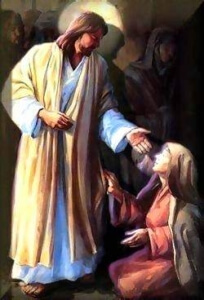By Monika Manser
Introduction
The most frequent way of praying that Saint Ignatius uses is that of imagining ourselves in a Gospel scene. We imagine ourselves as a character in the story. We take part in the story, seeing Jesus and all the other people, being aware of what’s going on and how we are feeling. The purpose of praying with the imagination is to allow Christ in the Scripture to speak to us. To bring the Gospel stories to life for us. We are not trying to recreate history. It doesn’t matter if your imagination takes the story off in a different direction to the Scripture. It doesn’t matter if the story takes place in 1st century Palestine or where we live now in the 21st century. What is important is what God wants to say to us through this passage.
Let us sit and relax so that together we can contemplate the Gospel using our imagination.
Prayer
We acknowledge we are in the presence of God so let us say together:
Direct O Lord and guide and influence all that is happening in my mind and heart during this time of prayer: all my moods and feelings, my memories and imaginings; my hopes and desires; may all be directed and influenced to your greater glory, praise and service and to my growth in your Spirit.
Amen
Let the Spirit guide our hearts and enlighten our minds to the mercy and compassion of God in our every day lives. We pray that we too can bring love, mercy and compassion to those we encounter.
Reading
John 8:1-11
Jesus went to the Mount of Olives. At daybreak he appeared in the Temple again; and as all the people came to him, he sat down and began to teach them.
The scribes and Pharisees brought a woman along who had been caught committing adultery; and making her stand there in full view of everybody, they said to Jesus, ‘Master, this woman was caught in the very act of committing adultery, and Moses has ordered us in the Law to condemn women like this to death by stoning. What have you to say?’ They asked him this as a test, looking for something to use against him. But Jesus bent down and started writing on the ground with his finger. As they persisted with their question, he looked up and said to throw a stone at her’
If there is one of you who has not sinned, let him be the first Then be bent down and wrote on the ground again. When they heard this they went away one by one, beginning with the eldest, until Jesus was left alone with the woman, who remained standing there. He looked up and said, ‘Woman, where are they? Has no one condemned you?’ ‘No one, sir’ she replied. ‘Neither do I condemn you,’ said Jesus ‘go away, and don’t sin any more.’
Contemplation
On this, the 5th Sunday of Lent, we continue to read about God’s love, mercy and forgiveness. Last week we read about the parable Prodigal Son from the Gospel of St Luke. This week we read of an account from St John’s Gospel of Jesus’ being caught in the middle of an altercation between the scribes and Pharisees and a woman caught in the act of committing adultery. I would like to share my thoughts with you as I enter the scene to listen to Jesus teaching at the temple.
I decided to go the market early that morning before the sun became too hot and also to escape the crowds. Even at that early hour the market was bustling with people selling their wares and the smells of fresh produce filled the early morning air. With the results I bought too much and my baskets were weighed down with fresh fruit, vegetables and some newly baked bread and pastries. As I laboured on the way home with my heavy baskets, I passed the temple, I noticed Jesus was there teaching the crowds. I always liked listening to Jesus because what he said was radical which could really rile the scribes and Pharisees who took exception to his teaching which attracted lots of tax collectors and those who were rejected by society. I felt this was a good time to put down my heavy bags and sit on the periphery of the crowd to listen to Jesus.
Then there was a bit of a bit of a commotion. I noticed a crowd of scribes and Pharisees dragging a woman. They threw her in front of Jesus and she landed on the ground by his feet. ‘Master”, they said in a sneering voice, “this woman was caught in the very act of committing adultery, and Moses has ordered us in the Law to condemn women like this to death by stoning. What have you to say?” I was furious. How dare these self righteous men humiliate and shame this woman in front of everyone. She must have felt so embarrassed.. I felt they were only using this poor lady to get at Jesus. Did she know she was being used as a pawn in their mind games? I was also angry at the fact that it was only this lady who was being condemned and not the man she was with. Doesn’t it take two people to commit adultery. Where was her accomplice. He had obviously let her take all the blame. Typical – men always get away scot-free. Surely she doesn’t deserve to be stoned to death? How cruel. I waited with baited breath to hear what Jesus would say. I felt he was caught in a quandary because if he said this woman should be forgiven, then he would be violating the law of Moses. How was Jesus going to get out of this one?
Jesus bent down and started writing on the ground. What was he writing? The accusers persisted with their charge and started picking up stones ready to throw. But Jesus threw the ball back in their court by saying “If there is one of you who has not sinned, let him be the first to cast a stone”. Then he bent down and continued writing on the ground. They all looked round at each other and dropped their stones. I watched the accusers slowly slink away in silence. I wonder if they felt ashamed or humiliated or even angry. It was only Jesus and this poor lady who were left. He kindly offered her his hand and helped her to her feet. He looked at her with love as he said, “Has no one condemned you?’ ‘No one, sir’ she replied. ‘Neither do I condemn you, go away, and don’t sin any more.’ They walked off together.
I went to the spot where Jesus had been writing to see what he had written. There were no words only doodles. I went to pick up my baskets of shopping and walk home. As I walked I pondered the scene. Why did Jesus doodle? Was the first time to give him a chance to discern the next move? Was the second time not to shame those who had the stones in their hands and to give them a chance to leave discretely? I will probably never know. All I know is that mercy and compassion is a high priority in the teaching of Jesus and that those who encounter him have a life-giving experience.
I now invite you into the scene to ponder on the story. Who do you identify with? The accusers? The woman? Jesus? Is there someone in your life you are called to forgive? Do you feel the need for forgiveness? Do you wonder what Jesus is writing on the ground? Could it be a message for you? Speak to Jesus about what is going on in your mind and listen to him telling you of his love and mercy for you.
Let us now spend ten minutes in quiet contemplation.
Sharing
Let us now share what we thought, felt etc. only if you are comfortable to do so.
End Prayer
Suscipe of St. Ignatius of Loyola
Take, Lord, and receive all my liberty,
my memory, my understanding,
and my entire will,
All I have and call my own.
You have given all to me.
To you, Lord, I return it.
Everything is yours; do with it what you will.
Give me only your love and your grace,
that is enough for me.
Scripture texts: from the Jerusalem Bible 1966 by Dartington Longman & Todd Ltd and Doubleday and Company Ltd




